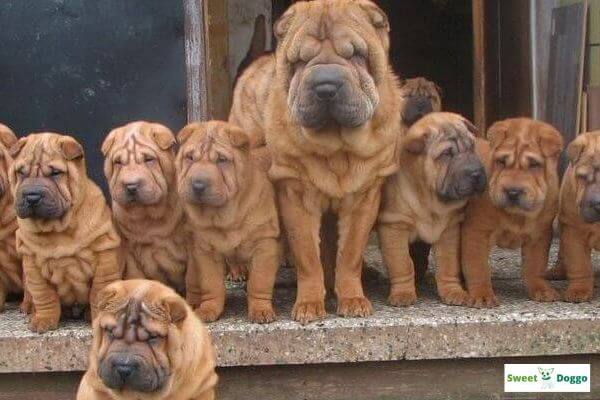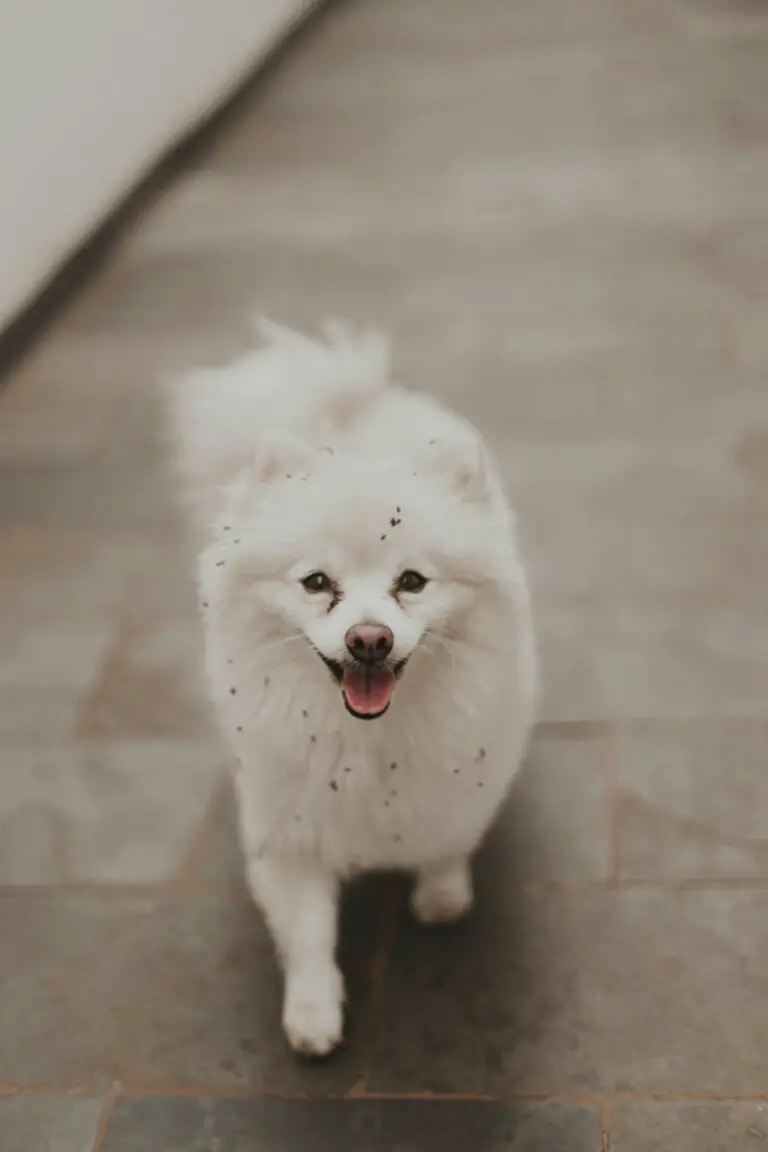Emerged in the Chinese province of Guangdong, it is believed that the original Shar-pei was a more elegant and less wrinkled dog than the current Shar-pei. Being such an old breed, it is normal for Shar-peis to have undergone changes and variations in many of their characteristics.
Are you interested in knowing how many types of Shar-pei there are? Do you want to know how to identify if a Shar-pei is original?
Read on below to find out how this breed differs, what the most common colors are, and what are the key characteristics you’ll want to look for when buying.
Table of Contents
What are the types of Shar-pei? variations in fur
In general, there are 3 types of Shar-pei, whose main difference is the texture and length of their coat. They are the horsehair shar-pei, the brush hair shar-pei, and the bear hair shar-pei.
Curious fact: Shar-Pei means “sand skin,” a reference to this breed’s rough, short coat. Formerly, the Chinese valued the Shar-pei for its unusual blue-black tongue, as they believed that, by barking, these dogs warded off evil spirits.
1. Horsehair
As their name suggests, Horsehair Shar Peis have the shortest and coarsest type of coat of all. Their appearance changes significantly from when they are puppies until they reach adulthood.
As a puppy, the Pony Shar Pei looks like a small ball of wrinkled fur; however, as an adult, it has smoother skin, with a slim, athletic build. This is said to be the most active and energetic variety within the breed.
Since they don’t develop an undercoat during the winter, Horsehairs shed less than other types of Shar Peis. That is why they are considered less suitable for life in cold climates.
The “horsehair” type has a coarse, short coat, with very wrinkled facial skin and a sad expression in its eyes like a puppy.
Warning. Some people may experience some sensitivity to Shar Pei’s rough coat. In that case, it is possible to develop a mild and short-lived rash, especially on the skin that has been in contact with it, commonly on the forearms.
2. Brush hair
The brush-haired Shar-Pei exhibits a slightly longer and softer coat than its pony-haired cousin. It is considered by many to be the most popular type of Shar Pei, probably because it retains the wrinkles on its skin as an adult.
Other characteristics that differentiate it from the horsehair shar-pei are its more robust and heavier build, as well as a larger head and snout. These specimens tend to have a more relaxed temperament, which is why they enjoy life inside the home.
Brush-haired Shar Peis retain their wrinkly puppy-like appearance throughout adulthood. They are normally slightly less active than horsehair shar-peis.
3. Bear hair
The Bear Hair Shar-Pei is said to be the rarest variety of Shar-Pei. Typically, it exhibits a long, fluffy, fluffy coat, similar to the coat of its Chow Chow ancestors.
These specimens are the product of a recessive gene in both parents; the gene must be in both the female and the male for a bear-haired shar-pei to be produced. Although undoubtedly attractive, this type of Shar Pei has not been accepted in many dog show rings.
Bear Hair Shar Peis have long, soft fur, the top layer of which is made up of hairs over 1 inch (2.54 cm) in length. Being considered a fault, these specimens are not accepted by the American Kennel Club and other official clubs.
How are the Chinese Shar-pei different from the American Shar-pei?
When talking about types of Shar Pei, it is also important to mention the two breeding lines within this breed: the Chinese Shar-Pei or Standard Shar-Pei and the American Shar-Pei or Western Shar-Pei. The shape of the muzzle is one of the main differences between the two dogs.
How can you tell them apart?

Physical Characteristics of the Chinese Shar-Pei
The Chinese shar-pei always has a narrower, bonier snout, hence it is commonly called the bony-mouthed shar-pei. His cheeks are not fleshy, nor is there a bulge ( pudding ) over his nose.
Since it is a dog designed for hunting, there are no skin wrinkles around the mouth that could affect the power of its bite.
- Looking from above, the muzzle is always thinner than the width of the skull (wedge-shaped).
- The length of the skull is almost equal to the length of the muzzle. When the dog opens its mouth, he gives the impression of smiling, adopting the gesture known to the Chinese as “toad mouth”.
- Large, open nostrils allow the animal to get needed oxygen while its mouth is closed.
- The shallow eyes are large and almond-shaped.
- The skin has a few folds, which are located mostly on the forehead and other parts of the head.
- The ears can be small and erect, or dropped and slightly larger.
- Chinese or traditional shar-pei is always taller compared to Americans. His body is athletic and light; never looks like a heavy dog.
- Its legs are straight, strong, and long, with flat palms and long fingers, noticeably separated.
- The tail with a thick rounded base tapers to a fine point.
- The typical colors of the Chinese shar-pei are brown, cream, and rusty black. A Chinese Shar-Pei should not have blue, lilac, chocolate, flowery, or sable colored coats.
Physical Characteristics of the American Shar-Pei
Unlike the Chinese Shar-Pei, the American Shar-Pei has a broad, meaty snout, hence it is also known as the Meaty-Mouth Shar-Pei. Its neck and mouth are covered by thick folds of skin.
- The shape of his head is square, rather than wedged.
- The tip of its nose is higher than the snout, and its nostrils are narrow.
- The eyes are located very deep in the skull.
- It is a compact dog, with a heavy structure.
- Its legs are short and its tight fingers simulate the paws of a cat.
- The tail is significantly thick at the base and thinner at the tip.
- American Shar Peis can be a variety of colors, from black, fawn, red, cream, and chocolate, to blue, blue-black, lilac, and flowery.
- Unlike the Chinese Shar-Pei, which has specific anatomy and morphology, the American Shar-Pei is divided into sub-types based on its coat and mouth morphology.
This includes the fleshy mouth or bony mouth brush hair shar-pei, the fleshy mouth or bony mouth horsehair shar-pei, and the bony mouth fleshy shar-pei, among others.
Did you know…? Shar Pei’s wrinkles give it more than just a special appearance. Originally bred to protect Chinese royalty more than 2,000 years ago, these dogs’ loose skin provided protection from attack.
What color can a shar-pei be?
Just like any other breed of dog, Shar-Peis can come in many different colors. These colors are divided into:
- Basics
- Diluted
- Flowered or not solid
- Shar-peis of basic colors
They exhibit black or charcoal pigmentation on the skin, nose, tongue, mouth, and footpads.
Here are the shades:
- Cream. They can be dark cream or light cream. Cream Shar Peis typically have a darker (apricot) shading on their backline, ears, and hocks.
- Beige. It is the most common Shar-Pei color and can include light beige, dark beige, and fawn.
- Red. Shades of red can range from red to mahogany or chestnut red.
- Brown. Brown Shar Peis are often confused with Chocolate Shar Peis. A brown specimen will have black pigmentation, while the chocolate will be diluted.
- Saber. The true sable will have a cord of black hairs on a lighter background color (never white). The coat color is uniform over the body, neck, head, and legs.
- Silver. They are light silver-colored dogs, with a charcoal-toned masks. They project a platinum tone similar to the cream color, but without the darker dorsal stripe.
- Black. Most black Shar Peis exhibit gray, red, silver, brown, or chocolate shading.
Shar Peis of diluted colors
Dilute Shar-peis does not show black pigmentation at the points, nor do they have black hairs on their body. The skin, nose, and nails are the same color as the coat in question; for example, dilute cream dogs will have pink noses and fur, while chocolate dogs will also have these parts in a chocolate tone.
In this group include the colors:
- Apricot. The apricot shade varies from light apricot to dark apricot.
- Blue. Blue brush-haired Shar Peis are usually a dark blue hue, and blue horse-haired Shar Peis are a light silvery blue.
- Chocolate. A diluted chocolate specimen may not have any black pigmentation on its body. The nose is chocolate colored and the tongue is a lavender shade.
- Diluted cream. It is the same as the basic cream color, but without the black pigmentation.
- Isabella. These shar-peis have a powdery pink coat with pale blue shadows on the face and a lavender tongue. The ears and dorsal lines may be darker.
- Lilac. It is a diluted chocolate blue color that gives the appearance of purple. Again, the color is darker in brush-haired Shar Peis than in horse hairs. It is only found as a diluted tone.
- Diluted red (5-point red). The “5 points” are the nose, the eyes, the skin, the pads, and the anus. These dogs are a deep fawn shade of red that varies to a dark red color.
- Diluted sable. They show a cord of dark (not black) hair on a lighter (not white) background color. The coat color is uniform on the body, neck, head, and legs.
- Dilute silver. Silvers include blue, gray, and taupe. The nose of these dogs is a slate tone (dark gray) and the tongue is lavender. It is a smoky bluish/silver color with very little variation.
flowered shar-peis
Shar Peis that are not solid in color are generally referred to as “flowery.” This includes all specimens that have color markings, i.e. spots and patches, but not those that have shading (darker fur on the back, lighter fur under the tail, ash sheen on the black shar pei, etc…).
Flowered dogs are considered purebreds and possess the same characteristics as their solid-colored relatives. These should have at least one solid color on the head, with a reverse mark on the back of the head (“^”).
The body must be at least 50% white with patches and markings of the same color on the rest of the body. The color can be any shade allowed in the solid shar pei coat. In general, this is considered a fault in the breed standard and therefore it is not accepted in show rings.
Note. Some of the shar pei colors are often considered “rare”. Although these colors are not usually seen as often, the truth is that they do not increase the value of the dog compared to other purebred Shar Peis.




